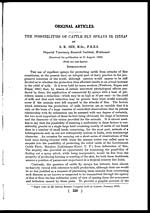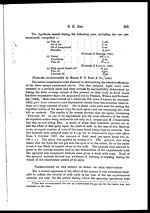Medicine - Veterinary > Veterinary colleges and laboratories > Indian journal of veterinary science and animal husbandry > Volume 9, 1939 > Original articles > Possibilities of cattle fly sprays in India
(248) Page 340
Download files
Individual page:
Thumbnail gallery: Grid view | List view

340 The Possibilities of Cattle Fly Sprays in India
extent to which cattle are liable to be terrorized by attacks of flies, the writer
cannot do better than reproduce the following passage from a letter addressed
by one of the authorities in charge of the farm referred to above : ' The cows
are worried both by day and night by flies. You saw how they always stood
huddled together so as to give one another as much protection as possible.
They graze in the same way even during the night. They are constantly
jostling one another and only a few leading the herd get any decent grazing.
One of the two newly purchased bulls from Ferozepur simply refuses to stay
with his herd at all on account of fly trouble and wants to spend the whole
day under cover.'
The experiments that are to be described presently were carried out
during September-October in two consecutive years, when the two prevalent
species of biting flies on the farm were Lyperosia exigua and Musca crassirostris.
The former, in particular, was a source of great annoyance by reason of the
determined manner in which it attacked its hosts, which included calves as
young as one month old. Curiously, Stomoxys calcitrans which, as in most
other countries, is a ubiquitous pest of cattle in India, was conspicuously
absent at the time.
There were about 340 head of cattle on the farm, including 40 milch cows
and the majority of these were of the Sahiwal breed.
MATERIAL AND METHODS
In the trials carried out during the first year, only two sprays were tested
for their repellent action against the two species of flies mentioned above.
These were :—
(a) Graybill's formula (Jensen's modification) as given below :—
|
Hard soap |
. |
. |
. |
. |
. |
1 lb. |
|
Water . |
. |
. |
. |
. |
. |
1 gal. |
|
Petroleum |
. |
. |
. |
. |
. |
4 gal. |
|
Powdered naphthalene |
. |
. |
. |
4 oz. |
||
Dilute to one part emulsion to three parts water.
(b) ' Keep Green '.—This is a proprietary preparation issued by Messrs
F. S. Kerr & Co., Vulcan House, Ballard Estate, Bombay, and is stated to be
a mixture of 'Pyrocide 20 ' (a concentrated extract of pyrethrum flowers) and
a soap spreader. For actual use, the product is diluted with water at 1 : 15.
In the beginning, the preparations were sprayed on the bodies of the
animals with a ' Flit' sprayer, but, this having been found ineffective, they
were smeared with cotton wool. In spite, however, of this drastic method of
application, the preparations failed to exert any marked repellent effect on
the flies. The results obtained with ' Keep Green ' were communicated to
Messrs F. S. Kerr & Co. and in reply they suggested the use of ' Pyrocide 20 '
in combination with pine oil and gas oil (infra) , a combination which had
been previously used as a mosquitocide with what would appear to be a con-
siderable amount of success by Sinton and Wats [1935].
Set display mode to: Large image | Zoom image | Transcription
Images and transcriptions on this page, including medium image downloads, may be used under the Creative Commons Attribution 4.0 International Licence unless otherwise stated. ![]()
| Permanent URL | https://digital.nls.uk/75247245 |
|---|
| Description | Covers articles from 1939. Please note that pagination starts at p.139 and plates at Plate V. |
|---|




